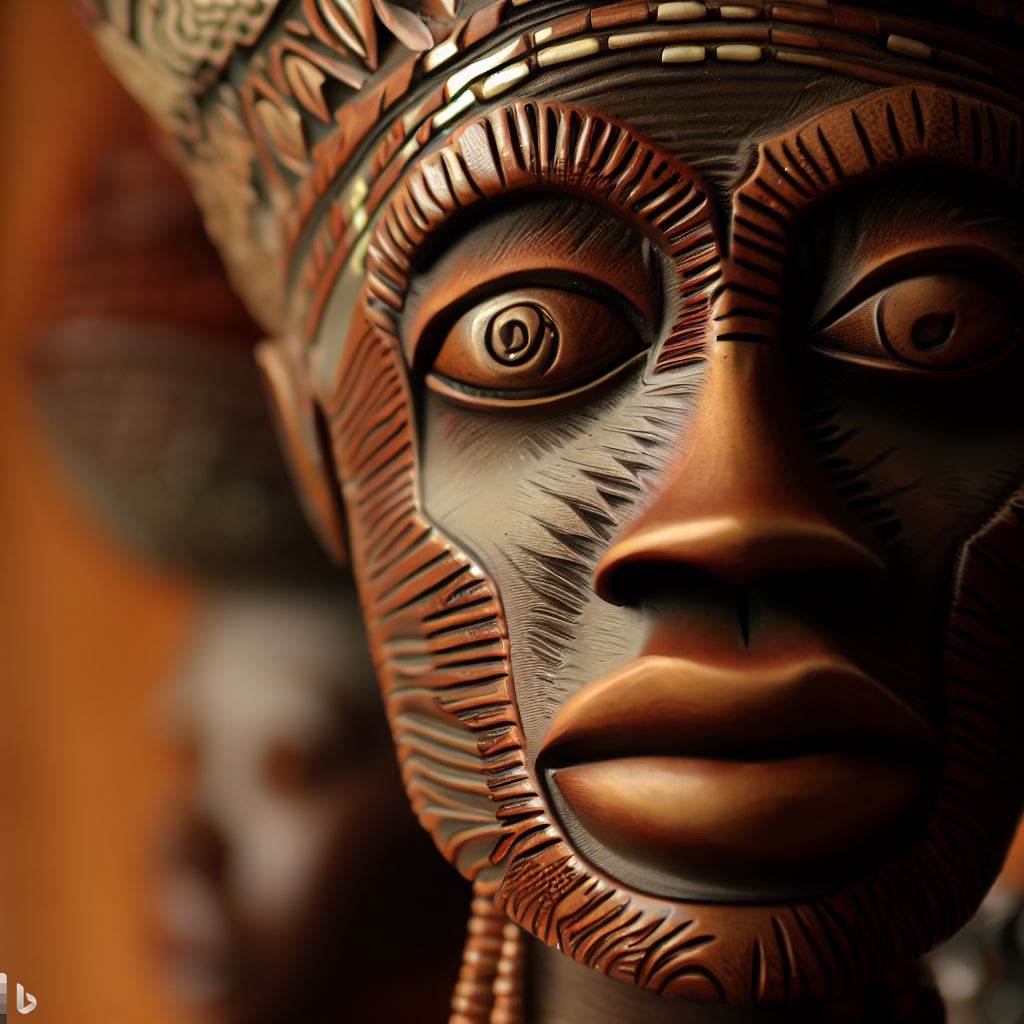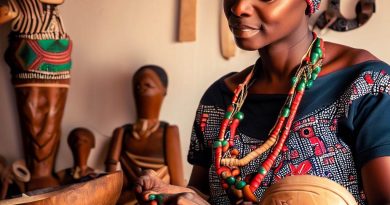Preserving Nigerian Craftsmanship: A Call to Action
Last Updated on January 27, 2024
Introduction
Nigerian craftsmanship is a reflection of Nigeria’s rich cultural and artistic heritage.
From pottery, weaving, woodcarving, and metalwork – Nigerian craftsmen have perfected their artistry to produce unique and beautiful pieces. It’s not just about creating beautiful items; it’s about preserving the culture, tradition, and identity of Nigeria. Without preserving Nigerian craftsmanship, we risk losing an essential aspect of our heritage.
Preserving Nigerian craftsmanship is not only vital for preserving Nigeria’s cultural heritage but also for promoting economic growth. The skills and techniques used in these crafts have the potential to create job opportunities for millions of Nigerians.
Furthermore, the exportation of Nigerian crafts can significantly contribute to the country’s GDP and improve its image on the global stage. The purpose of this blog post is to call for action to preserve and promote Nigerian craftsmanship.
Through this post, we hope to raise awareness of the importance of Nigerian craftsmanship, and encourage individuals, organizations, and government agencies to support and invest in Nigerian craftsmanship. We need to educate people on the value of Nigerian arts and crafts and create opportunities for the craftsmen to showcase their skills and promote their products locally and internationally.
In essence, preserving Nigerian craftsmanship is our responsibility as Nigerians.
By promoting and preserving our artistic heritage, we keep our culture and history alive, create employment opportunities, boost economic growth, and put Nigeria’s creativity on the map.
Together, we can safeguard and promote Nigeria’s unique artistic heritage for future generations.
Background information on Nigerian craftsmanship
- History of craftsmanship in Nigeria
- Various crafts and art forms in Nigeria
- How Nigerian craftsmanship has evolved over time
Nigeria boasts of a rich cultural heritage and history, and one of the most significant aspects of this heritage is its craftsmanship.
Nigerian craftsmanship refers to the various art forms and crafts indigenous to the country, which have been passed down from generation to generation.
These crafts have evolved over time, showcasing the creativity and ingenuity of the Nigerian people.
History of Craftsmanship in Nigeria
Craftsmanship in Nigeria dates back to thousands of years ago, as evidenced by archaeological discoveries.
Nigerian craftsmanship has its roots in the country’s indigenous religions and rituals and was used to create objects that served practical or symbolic purposes.
Traditional Nigerian crafts include pottery, weaving, carving, beadwork, and basketry, among others. These crafts were essential for everyday life and were also used in religious and cultural ceremonies.
Nigerian craftsmen were highly valued and respected members of society and were often commissioned to create works of art for royalty and nobles.
Various crafts and art forms in Nigeria
Some of the popular Nigerian crafts and art forms include beadwork, weaving, carving, and textile production.
Nigerian beadwork is known for its intricate designs and bright colors and is commonly used in jewelry-making and embellishing clothing and bags.
Weaving, on the other hand, refers to the creation of fabric from the interlacing of threads. Nigerian weavers create textiles from cotton, silk, raffia, and other materials. The art of carving involves sculpting wood, ivory, and other materials to create figurines, masks, and other objects.
Nigerian carvers are known for their intricate designs and attention to detail. Nigerian textile production involves the creation of fabrics using traditional and modern techniques.
How Nigerian craftsmanship has evolved over time
Nigerian craftsmanship has undergone significant changes over time, influenced by factors such as technology, globalization, and urbanization.
With the advent of modern tools and techniques, traditional crafts have evolved to include new elements while still maintaining their cultural significance.
For example, Nigerian fabrics are now produced using modern machines and tools, but the designs and colors remain distinctly Nigerian. Globalization has played a significant role in the evolution of Nigerian craftsmanship.
Nigerian crafts are now exported to other countries, exposing the world to the richness and beauty of Nigerian culture.
However, globalization has also posed challenges, such as the influx of cheap and low-quality imports that compete with locally-made crafts. Urbanization has also influenced Nigerian craftsmanship, with new trends and styles emerging in urban centers.
The Nigerian fashion industry, for example, has witnessed significant growth, with designers incorporating traditional crafts into their designs.
A Call to Action
Despite the rich cultural heritage and artistic prowess of Nigerian craftsmen, there are challenges that threaten the continued growth and development of this industry.
One of the major challenges is the lack of recognition and support from the government and private sector.
Therefore, it is essential to raise awareness about the importance of Nigerian craftsmanship and the need to preserve and promote it. This can be done through initiatives such as workshops, exhibitions, and cultural exchange programs.
Investment in the sector is also crucial, with funding and support needed to improve infrastructure, access to markets, and develop new and innovative designs.
In summary, Nigerian craftsmanship is a vital aspect of the country’s culture, history, and identity. It is essential to preserve and promote this cultural heritage by providing the necessary support and recognition.
Together, we can ensure that Nigerian craftsmanship continues to thrive and evolve for generations to come.
Read: Trade Skills: Empowering Nigeria’s Youth Population
Challenges faced in preserving Nigerian craftsmanship
Preserving Nigerian Craftsmanship: A Call to Action
Nigeria’s rich culture and heritage in traditional arts and crafts face challenges threatening extinction:
- Lack of interest in traditional crafts among younger generations.
- Competition from mass-produced goods devaluing traditional crafts.
- Limited access to materials and tools due to high costs.
- Financial constraints for craftsmen prioritize survival over their craft.
Initiatives to preserve Nigerian craftsmanship
- Raise awareness through school curriculum, apprenticeship, workshops, and cultural festivals.
- Provide financial support with grants, funding projects, and pro-craft policies.
- Build a vibrant domestic market to showcase traditional crafts.
- Establish apprenticeship programs to pass on craftmaking skills.
Preservation is crucial for future generations to experience Nigeria’s rich heritage and cultural identity.
Read: A Comprehensive Guide to Craft Apprenticeships in Nigeria

Uncover the Details: Future Forecast: The Craft and Trade Skills Sector in Nigeria
Possible solutions to preserving Nigerian craftsmanship
Promoting and creating awareness of traditional Nigerian crafts through the media, social networks, exhibitions, and events
One way to preserve Nigerian craftsmanship is by promoting and creating awareness of traditional Nigerian crafts. This can be achieved through exhibitions, events, and the use of social media platforms, among other things.
By creating buzz around traditional Nigerian crafts, more people will be interested in learning about them and thereby contribute to their preservation.
Encouraging the use of local materials and tools in crafting
Another way to preserve Nigerian craftsmanship is by encouraging the use of local materials and tools in crafting. This is critical because craftsmen often use imported materials and tools.
By using local materials and tools, craftsmen can create more authentic Nigerian crafts and preserve the culture better.
Developing partnerships with local and international organizations
Developing partnerships with local and international organizations is vital in preserving Nigerian craftsmanship.
This could be done by partnering with art institutions, non-profit organizations, and other cultural groups interested in preserving Nigerian culture and promoting the export of Nigerian crafts.
Furthermore, through these partnerships, craftsmen can benefit from exposure to different techniques, materials, and ideas while remaining true to the Nigerian heritage.
Providing training and financial support for craftsmen
To preserve Nigerian craftsmanship, craftsmen must have access to training and financial support. Besides, many craftsmen are self-taught, and despite their talent and passion, they require additional skills and knowledge to be successful.
Depending on the craft, training could include apprenticeships, masterclasses, or specialized courses. Financial support could take the form of grants, subsidies, or low-interest loans, among others.
Creating a market for traditional crafts
Lastly, creating a market for traditional crafts is essential in preserving Nigerian craftsmanship.
Achieve by establishing dedicated craft fairs, setting up shops for craftsmen to display and sell, and collaborating with retailers promoting authentic products.
By creating a market for traditional crafts, craftsmen can make a decent living through their trade, motivating them to keep their skills active and preserved. Essentially organizations. The government plays a crucial role in supporting these initiatives.
By creating an enabling environment, crafting skills can thrive, and the value of Nigerian heritage can be preserved for future generations.
Read: Impact of Modern Tech on Traditional Crafts in Nigeria
Preserving Nigerian Craftsmanship: A Call to Action
Nigeria has a rich cultural heritage that is reflected in its traditional craftsmanship. However, with the advent of modernization, the craft industry is on the decline.
This has prompted calls from concerned quarters for the preservation of Nigerian craftsmanship.
In this blog chapter, we will explore examples of successful preservation initiatives, the impact of preservation efforts on the community and economy, and lessons learned from successful preservation initiatives.
Case Studies of Successful Preservation Initiatives
The NCAC actively promotes Nigerian craftsmanship through workshops, exhibitions, and trade fairs. The private sector also initiates various efforts to preserve Nigerian craftsmanship.
Impact of Preservation Efforts on the Community and Economy
Preservation efforts have had a positive impact on both the community and economy.
By preserving traditional crafts, communities are able to maintain their cultural heritage. This helps to strengthen the sense of identity and pride among community members.
Preservation efforts have also created job opportunities in the craft industry, thus contributing to the economy.
The House of Tara, for instance, has created job opportunities for young Nigerians in the cosmetics and craft industries.
Lessons Learned from Successful Preservation Initiatives
One lesson that can be learned from successful preservation initiatives is the importance of collaboration between the government, private sector, and communities.
Collaboration ensures that preservation efforts are sustainable and reflect the needs of the community. Another lesson is the need for innovation.
Preservation efforts must be accompanied by innovation to ensure that traditional crafts remain relevant and attractive to a modern audience.
Additionally, preserving Nigerian craftsmanship is not an option but a necessity. It is a means of maintaining Nigeria’s cultural heritage, creating job opportunities, and contributing to the economy. However, this cannot be achieved by one individual or entity.
It requires collaboration between the government, private sector, and communities. It also requires innovation to ensure that traditional crafts remain relevant in a modern world. With concerted efforts, we can preserve Nigerian craftsmanship for generations to come.
Read: Craftsmanship as a Sustainable Livelihood in Nigeria
Conclusion
Preserving Nigerian craftsmanship is vital to protect the country’s cultural heritage and promote economic development through tourism.
We need to acknowledge and appreciate the hard work put into creating these crafts by skilled artisans who are often unappreciated.
By preserving Nigerian crafts, we contribute to the country’s economy by creating job opportunities for the artisans, and we also promote cultural tourism. It is crucial to promote and support local crafts by purchasing them and encouraging others to do the same.
Preserving Nigerian craftsmanship is a collective effort, not solely the government’s responsibility. We must encourage the younger generation to appreciate and learn traditional craft skills for passing them on.
As individuals, we can support artisans by investing in locally made crafts, promoting their work on social media platforms, and attending craft fairs and exhibitions.
Let us work together to preserve Nigerian crafts and promote our unique cultural heritage, showcasing it to the world.


